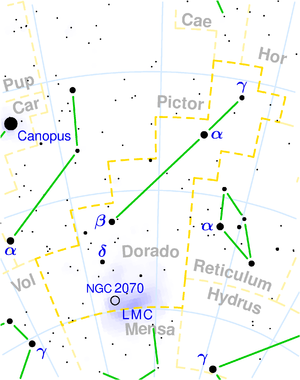 A faint and minor constellation of the southern sky south of Pictor, not rising in our area. The essentially inconspicuous region lies between the bright stars Canopus and Achernar. There is only one star brighter than fourth magnitude. However, if we look closely, we can see a bright white cloud on the boundary of the constellation with Table Mountain - the Large Magellanic Cloud. The constellation also contains the south pole of the ecliptic.
A faint and minor constellation of the southern sky south of Pictor, not rising in our area. The essentially inconspicuous region lies between the bright stars Canopus and Achernar. There is only one star brighter than fourth magnitude. However, if we look closely, we can see a bright white cloud on the boundary of the constellation with Table Mountain - the Large Magellanic Cloud. The constellation also contains the south pole of the ecliptic.
α Dor - The brightest star of the constellation has an apparent magnitude of 3.47. In reality, it is a close binary star, as there is a companion with a magnitude of 9.8 located 77.7" away from the primary component. It is located at a distance of 176 light-years.
β Dor - The variable Cepheid, which reaches a maximum brightness of 3.8mag and decreases to 4.6mag at minimum with a period of 9.84 days. This yellow-white supergiant is located at a distance of approximately 1,000 light-years. The suitable comparison star is delta Dor, which has a magnitude of 4.35mag.
SN1987A - A bright supernova, which appeared on February 23, 1987 in the Large Magellanic Cloud near the Tarantula Nebula and reached its maximum brightness of 2.8 magnitude. After 383 years since Kepler's supernova, the inhabitants of the southern hemisphere could admire another supernova visible to the naked eye. It shone in the sky for 10 months, but it is now very faint. It is likely that a pulsar remained after it, but it has not been found yet.
S Doradus - An exceptionally luminous star that surpasses the Sun in brightness by at least a million times. It is one of the most radiant stars in existence. However, due to its distance, it cannot be seen with the naked eye and is only perceived as a faint star, whose brightness fluctuates between 8th magnitude and 11.5th magnitude, as it is an eclipsing variable star. Its components have diameters 1,400 and 1,200 times larger than our Sun. Its absolute brightness is approximately -11.
NGC 2070
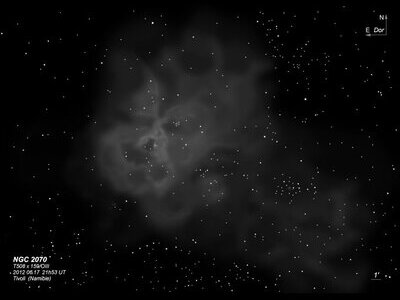
Nicolas-Louis de Lacaille discovered NGC 2070 = Lac I-2 = D 142 = h2941 in 1751-1752 using a half-inch refractor at 8x during his expedition to the Cape of Good Hope. He included it in his 1755 catalogue as Class I No. 2 and remarked "like the former [NGC 104: "like the nucleus of a fairly bright comet] but faint." James Dunlop reported D 142 as "a pretty large ill-defined nebula, of an irregular branched figure, with a pretty bright small star in the south side of the centre, which gives it the appearance of a nucleus. This is resolvable into very minute stars - Figure 4. is a very good representation of the nebula resolved. (N.B. The 30 Doradus is surrounded by a number of nebulae of considerable magnitudes, nine or ten in number, with the 30 Doradus in the centre.)"
On his first observation from the Cape of Good Hope, John Herschel noted "the great nebula; an assemblage of loops." He later discussed in detail, "This is one of the most singular and extraordinary objects which the heavens present, and derives no small addition to its intrinsic interest from its situation, which is among the thickest of the nebulae and clustering groups of the greater Nubecula, of whose total area it occupies one-five hundredth part. For these reasons, as well as because its real nature has been completely misunderstood, and its magnified appearance so strangely misrepresented in the only figure which I am aware to have been made of it as to convey an entirely erroneous impression both of its form and structure; I have taken great pains to give as nearly as possible a perfect representation of it as it appeared in the twenty-feet reflector on a great many occasions, but more especially on the 29th November, 1834, when a 'very careful drawing' was made of it by the eye alone, unaided by any micrometrical measures; and on the 21st and 22nd December, 1835, when the nebula was worked in from the telescope on a 'skeleton' previously prepared by an approximate reduction of the micrometrical measures of its principle stars, forming a chart, with a system of triangles, for its reception and for that of minute stars not susceptible of micrometric measurement, or not considered as of sufficient importance to be so measured. This is the only mode in which correct monographs can be executed of nebulae of this kind which consist of complicated windings and ill-defined members obliterated by the smallest illumination of the field of view; and in which the small stars, when very numerous, can be mapped down with tolerable precision. The following catalogue contains all the stars which I have been able distinctly to perceive within the area occupied by the nebula and nearly adjacent to it... [The catalogue contains 105 stars.] The stars thus scattered over the area occupied by this nebula may or may not be systematically connected with it, either as an individual object, or as part of the vast and complex system which constitutes the Nubecula. In respect of their arrangement there is nothing to distinguish them from those which occupy the rest of the area covered by the Nubecula, in which every variety of condensation and mode of distribution is to be met with. The nebula itself (as seen in the 20-feet reflector) is of the milky or irresolvable kind - quite as free from any mottling or incipient stellar appearance as any other nebula which I can remember to have examined with that instrument. Its situation in the Nubecula is immediately adjacent to two large and rich clusters [NGC 2042 and NGC 2055]. Mr Dunlop remarks that 'The 30 Doradus is surrounded by a number of nebulae of considerable magnitudes, nine or ten in number, with the 30 Doradus in the centre.', of which nebulae he gives a figured representation. For what objects these can be intended I am quite at a loss to conjecture, unless they be the brighter portions of the nebulous convolutions seen without their connecting enbranchments. But with this supposition their relative situations, intensities, and magnitudes in the figure alluded to, so far as I am able to judge, appear irreconcilable."
300/350mm - 12" (6/29/02 - Bargo, Australia): first view of the Tarantula in Les Dalrymple's 12" was early in the evening, very low in the southern sky (20° elevation) and without a filter. Even under these conditions it was a fascinating sight – fairly bright, detailed, 15' convoluted, mottled nebulosity with several striking loops or ribbons which radiate out from the central region. Sweeping in the nearby fields I ran across numerous small knots of nebulosity and small clusters.
10x30mm (1/21/12): I viewed the Tarantula Nebula in a 19" dobsonian (pointed horizontally) and in my IS binoculars. At a declination of -69.1°, the Tarantula just skimmed the horizon from the 9300' Mauna Kea Visitor Center, culminating 1.1° above the horizon! Still with atmospheric refraction, it was obvious in the binoculars. There was too much extinction and seeing effects for much structure in the 19".
400/500mm - 18" (7/8/02 - Magellan Observatory, Australia): NGC 2060 lies 6.5' SW of the central cluster (R136) of the Tarantula. It appeared as a fairly small knot of nebulosity, ~2' diameter, with about a half-dozen mag 12-14 stars involved (association LH 99) in the glow. A mag 12 "star" on the north edge has been resolved into a very compact cluster by the HST. Studies have shown this nebula contains a compact x-ray source and a rapidly rotating pulsar, indicating NGC 2060 is a Crab-like supernova remnant in the LMC (1998 IAU Circ., 6810, 2).
Hodge 301 is the oldest cluster in the Tarantula (age 25-30 million years) and is situated just 3' NW of the central cluster (R136). It appeared as a coompact 30" knot with a half-dozen mag 13-14 stars resolved over haze.
600/800mm - 24" (11/18/12 - Magellan Observatory, Australia): at 200x unfiltered, I examined the 30 Doradus cluster = R136 cluster at the heart of the Tarantula Nebula. The cluster is dominated by R136a, a 10th magnitude bloated "star" at the center that would not focus sharply. Surrounding this star was a compact but very rich carpet of dozens of mag 14-15.5 stars packed into a 1' region that were much too numerous to count.
24" (4/5/08 - Magellan Observatory, Australia): The Tarantula nebula was simply unreal at 200x in the 13mm Ethos with a UHC filter -- better than any photo I've seen and convincingly 3-dimensional, even though I viewed it late so the elevation was only 20°. Although this magnification brought out an unbelievable amount of detail in the loops and ribbons, the main complex fit snugly in the eyepiece field (30').
Naked-eye - at 5th magnitude or so, the Tarantula is obvious from a fairly dark site as a small, fuzzy patch on the eastern side of the LMC, north of the central bar.
Notes by Steve Gottlieb
NGC 1553
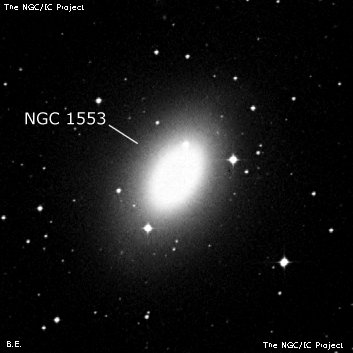
James Dunlop discovered NGC 1553 = D 331 on 5 Nov 1826 and described "a rather bright nebula about 1' diameter, very faint at the margin, gradually bright to the centre: a small star north, and another south, both involved in the margin of the nebula. A group of very small stars north." Dunlop made a 1 hr copying error in his RA (verified by Glen Cozens after examining Dunlop's original observations), and his corrected position is only 10' S of this galaxy, a typical error. Wolfgang Steinicke equates D 331 = NGC 1549, but that seems less likely, as Dunlop's description of two stars involved and a group of stars to the north (near NGC 1549) applies to NGC 1553. But it is surprising that Dunlop apparently missed NGC 1549. On his first sweep (5 Dec 1834), John Herschel recorded "vB, R, gmbM, 60", between three stars."
300/350mm - 13.1" (2/19/04 - Costa Rica): very bright, oval, elongated 5:2 NNW-SSE, 2.25'x1.0', very bright core, fairly high surface brightness halo. With averted vision the halo increases to nearly 3' in length. A mag 12.5 star is at the north edge [1.0' from center], a mag 12.5 mag star is off the SSE edge [1.7' from center] and a mag 12 star is 1.8' WNW of center. Forms a bright pair with NGC 1549 12' NNW in the center of the Dorado Group. IC 2058 lies 17' SE.
Notes by Steve Gottlieb
NGC 1566
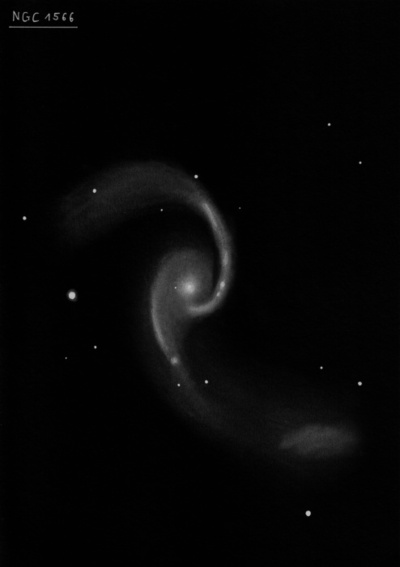
James Dunlop discovered NGC 1566 = D 338 = h2635 on 28 May 1826 with his 9" reflector from Parramatta and described "a pretty large round nebula, about 4' diameter, moderately and gradually condensed to the centre. A very small star near the following edge, not involved." His position is 11' too far south but the identification is certain.
John Herschel observed the galaxy twice from the CGH, recording on 5 Dec 1834, "B, vL, first very gradually then suddenly much brighter to the middle, to a stellar nucleus. Diameter in RA = 15". A star 11th mag involved, N.p. gives it a distorted appearance. A curious object." JH noted this nebula could be Dunlop 338.
Pietro Baracchi observed the galaxy on 7 Dec 1885 with the 48" Melbourne Telescope. His sketch clearly shows both spiral arms and his description reads "the nebulosity is very faint and has a shape almost like the letter S."
300/350mm - 13.1" (2/19/04 - Costa Rica): this Seyfert galaxy is a member of the Dorado Group and appears bright, large, elongated 3:2 ~N-S. With careful viewing the halo extends to ~3'x2'. A spiral arm is attached on the west side and curves towards the north beyond the main body of the galaxy. On the eastern side a low surface brightness arm is attached (on an E-W line with a mag 12 star close following the galaxy) and extends a little to the south on the eastern side of the main body. I was surprised to see the spiral arms so clearly! Mag 8.2 HD 27713 lies 5.4' NW of center and a mag 9.9 star lies in the field 9' W. NGC 1581 lies 40' E.
600/800mm - 24" (11/18/12 - Magellan Observatory, Australia): at 260x, this gorgeous spiral was a showpiece treat even with a 4.5-day moon well up in the west. NGC 1566 appeared strongly concentrated with a very bright, elongated 1' core region that increased to an intense, round, 20" nucleus. The two spiral arms were easily visible with direct vision. The "southern" arm is attached on the north side of the core, wrapping around the core counterclockwise on the east side (passing directly between the core and a mag 12 star 2' E of center) and spiraling around 180? to the south side of the halo. On the south end, the arm passes just north of a mag 15 star and ends at a slightly brighter mag 14.5 star. The "northern" arm is attached on the south side of the core and wraps around the west side, gradually unfurling towards the north side and ending over 2' NNE of center.
With careful viewing, the northern arm "resolved" into 4 distinct extended HII regions, identified as NGC 1566:[HP80] I, II, IV and VI in Hawley and Phillips 1980 paper "Spectrophotometry of H II regions and the nucleus of NGC 1566" in ApJ, 235, 783. NGC 1566:[HP80] VI is a 12" knot in the arm, 45" due west of center and is clearly resolved from [HP80] IV, a slightly larger 15" knot which is 50" WNW of center. [HP80] II is a distinct 10" knot 1' NNW of center and the faintest is [HP80] I, just to its north. The arm passes just south of a mag 14 star 2' N of center. With averted vision, the outer halo extends beyond the main arms, increasing the size to 5'x3' SSW-NNE. Mag 8.7 HD 27713 lies 5.4' NW. NGC 1566 is the largest and most luminous member of the Dorado Group, which contains three subgroups: NGC 1433 group, NGC 1672 group and NGC 1566 group.
Notes by Steve Gottlieb
NGC 1672
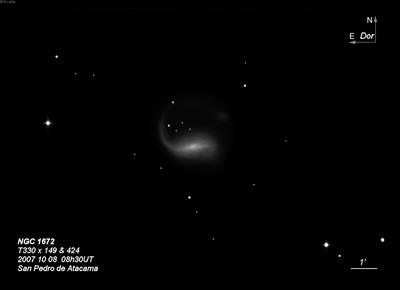
James Dunlop discovered NGC 1672 = D 296 on 5 Nov 1826 and described "a faint ill-defined nebula, with a small bright point in the preceding side, which I suspect to be a star; there are several similar small stars in the field." His position was off by 15' to the NW. John Herschel, who made two observations of this barred spiral, was uncertain if D 296 was equivalent to h2665. On the first sweep he logged "B, L, pmE, svmbM to a nucleus; 2.5' long, 1.5' broad; a star 12th mag involved." His position was accurate.
Joseph Turner sketched NGC 1672 on 5 Dec 1876 with the 48" Great Melbourne Telescope but there was no indication of spiral structure (unpublished lithograph plate II, figure 16).
300/350mm - 13.1" (2/19/04 - Costa Rica): fairly bright, fairly large, elongated 3:2 ~E-W, ~3'x2'. Sharply concentrated with a very small, bright core, ~20" diameter, and a large oval halo. Spiral structure was evident as an ill-defined extension or haze off the NE side, though I could not resolve this spiral arm clearly. Situated directly between two mag 9 stars 10' SW and 6.5' ENE. Located 30' NNE of mag 5.3 Kappa Doradus. This galaxy is a member of the Dorado group, which includes NGC 1515, NGC 1533, NGC 1536, NGC 1543, NGC 1546, NGC 1553, NGC 1566, NGC 1574, NGC 1596, NGC 1617 and IC 2056. Possible additional members include NGC 1559, NGC 1602, NGC 1672, NGC 1688, NGC 1703 and NGC 1705.
400/500mm - 18" (7/8/02 - Magellan Observatory, Australia): this striking spiral galaxy appeared fairly bright and large, ~4' diameter, sharply concentrated with a very bright core. Clearly emerging from the east side of the oval core or bar was a spiral arm which curled north and wrapped around two stars to the NW of the core. The extension on the west side was just a very faint, diffuse haze on the SW side without a sharply defined arm structure. A mag 9 star is 6.5' ENE and a mag 6.5 star (HD 30790) is 13' NE.
600/800mm - 24" (4/5/08 - Magellan Observatory, Australia): this gorgeous barred spiral appeared very bright and large with the main body elongated E-W, extending ~3.5'x2.0'. An obvious spiral arm is attached at the east end of the E-W central bar. This arm hooks to the north, wrapping around a superimposed star to the northeast of the bar (1.6' from the center). Three fainter stars with separations ~30" are sandwiched to the west of this star, between the arm and the bar. The arm fades out before reaching a mag 10 star 2.2' NE of center. A second arm begins to emerge on the west side of the bar, barely sweeping towards the south before abruptly terminating. So the second "arm" is just a small hooking appendage off the west end. The central bar itself is sharply concentrated with a dramatic, brilliant nucleus, ~25" diameter, that increases gradually to the center.
Notes by Steve Gottlieb
NGC 2055
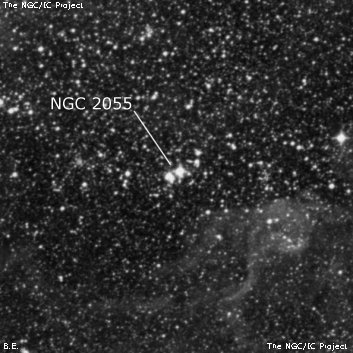
Within this cloud is S-L 610 (often misidentified as NGC 2055), a small knot of four stars in a 1' region. It includes two bright "stars" (R127, V ≈ 10.5 and R128, V ≈ 10.7 ) at 20" separation, along with two 12th mag stars to the northwest. Both R127 and R128 are very compact clusters with R127 containing the brightest Luminous Blue Variable (LBV) in the LMC! NGC 2050 is probably a group of stars on the north side of the cloud. Roughly ~20 stars were resolved including a mag 10.6 star at the west edge and a mag 10.7 star (11" double) at the southwest edge. The central part contains several mag 12 stars and HD 38030, a mag 13.0 Wolf-Rayet (Brey 68).
A long stream of mag 10-12 stars begins about 12' W of the cluster and extends east-northeast for over 20', including NGC 2050 and association LH 97 at the NE corner of the large star cloud, and passing just south of the Tarantula Nebula.
John Herschel discovered NGC 2055 = h2931 on 24 Nov 1834 and noted "a vL v rich cluster of sc st 10...15 which more than fills the field." His position is near the center of this large association or star cloud (LH 96), which includes NGC 2050 and S-L 610.
300/350mm - 14" (4/4/16 - Coonabarabran, 145x): roughly 120 stars are resolved in a gorgeous 15'x10' SW-NE star cloud (association LH 96) situated to the south of the Tarantula Nebula. The cloud is rich in faint stars but also includes a mag 9.6 star (HD 269820) at the southwest edge, along with a few other mag 10.5 stars. The background shows unresolved haze and perhaps nebulosity. Adding an NPB filter, there is definite nebulosity in the northeastern quadrant of the cloud. It spreads northwest and northeast, merging with the outer tendrils of the Tarantula Nebula!
Notes by Steve Gottlieb
NGC 2074
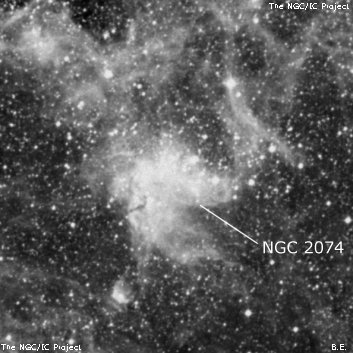
NGC 2074 is part of a huge Superbubble complex (LMC-N158) stretching 11' SW-NE with NGC 2081, a bright HII region that lies just 8' NE. LMC-N158 is located roughly 20' SSE of the center of the Tarantula Nebula.
John Herschel discovered NGC 2074 = h2942 in 1834-1835 (exact sweep or date unknown as based on a detailed sketch of the Tarantula Nebula (NGC 2070) region made over several nights in Nov 1834 and Dec 1835) and recorded as "pL, pB, mE, of irreg rounded and somewhat serpentine figure, much brighter in its foll part; elongated generally in parallel. Involves 5 stars, 2 of which are 10th mag. See Notes in 'First Approximation Towards a Catalogue of Objects in the Magellanic Clouds...'." His position is ~1' W of center.
600/800mm - 24" (4/10/08 - Magellan Observatory, Australia): this prominent HII region (LMC-N158C) and cluster (OB-association LH 101) appeared as a very bright, very large "C" shaped nebula surrounding a semi-circular chain or crown of stars open to the SW. Two bright mag 10.4 and 11 stars oriented SW-NE (50" separation) lie on the northwest end of this crown. The northeastern luminary consists of a 1.8" pair of OB-stars (TDS 3273 = 11.4/11.8) and a mag 12.5 Wolf-Rayet star just 3" W. The mag 11 star to its southwest (HD 269923) is the brightest single star (A0-class) in the cluster. In addtion, a mag 12.5 star (O3-class supergiant) is situated on southeast end of the chain. A bright knot of diameter ~35" is superimposed on the general glow within the northeast side of the "C". At 216x at least 20 fainter stars were resolved in the chain besides the brighter stars at the ends.
Notes by Steve Gottlieb
NGC 1829
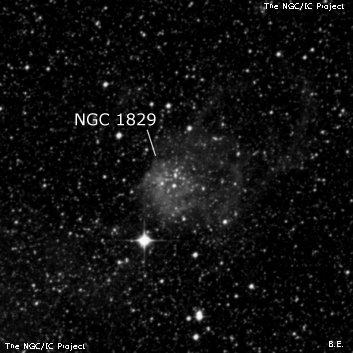
John Herschel discovered NGC 1829 = h2760 on 13 Dec 1835 and recorded "F, R, 60", r[esolvable]." His position (single sweep) is accurate.
600/800mm - 24" (11/18/12 - Magellan Observatory, Australia): this LMC cluster and HII region (LMC-N23A) appeared bright, fairly large, irregular round, 1.5' diameter. Four stars are within the nebulous glow including a mag 13.5, two mag 14 stars and a mag 15 star. Located 1.8' NW of mag 7.9 HD 33486. The surrounding region includes several mag 12-13 stars, but these are detached from the glow. HS 114 lies 6.3' ENE.
Notes by Steve Gottlieb
NGC 1965
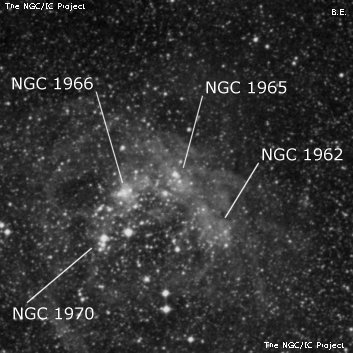
John Herschel discovered NGC 1965 = h2867 = D 136? on 31 Jan 1835 and recorded "F, S; the second of a group of four nebulae [with NGC 1962, 1966 and 1970] with stars. The place interpolated from those of the 1st and 3rd by aid of a diagram made at the time. Plate VI, figure 20."
Herschel noted Dunlop 136, discovered on 25 Sep 1826 probably includes h2867. James Dunlop wrote, "a faint confused pretty large nebula. There are a multitude of small nebulae in this place." Dunlop's position is ~10' too far SW (typical error), though he did not distinguish the individual components of the complex, at least in his published description. The entire group was also sketched by Joseph Turner in Dec 1875 using the 48" Great Melbourne Telescope (plate III.30 at www.docdb.net/history/texts/1885osngmt________e/lithograph_m_3_30.php)
600/800mm - 24" (4/7/08 - Magellan Observatory, Australia): this is a bright, small knot on the NW side of a large HII complex and cluster (association LH 58) that includes NGC 1966 (1.5' ESE), NGC 1962 (2.2' SW) and NGC 1970. NGC 1965 surrounds two stars and ~20" in diameter with a fainter nebulous halo.
Notes by Steve Gottlieb
NGC 1966
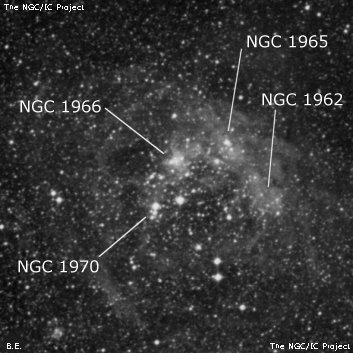
At 200x using a UHC filter, this is a fascinating emission complex as the entire 5' region is awash in bright nebulosity and there are faint, irregular extensions beyond the main portion, particularly to the north (the outer portions form a faint bubble on images). A 10th mag star is involved, though the cluster itself (S-L 476) does not stand out significantly.
NGC 1966 is sometimes applied to the entire complex. Shapley listed the complex as the center of the OB-association "Constellation" II (of V).
John Herschel discovered NGC 1966 = h2868 on 31 Jan 1835 and recorded "the third of a group of four nebulae with stars; pB, R, pslbM. Plate VI, figure 20." Herschel notes this might be Dunlop 77 (two question marks), but this must be an error as the position of D 77 is roughly 04 56 07 -70 07 (2000). Dunlop discovered the entire group (D 136 = S-L 476) and described "a faint confused pretty large nebula. There are a multitude of small nebulae in this place." His position is ~10' too far SW (typical error), though he did not distinguish individual components.
The entire group was also sketched by Joseph Turner on 22 Dec 1875 using the 48" Great Melbourne Telescope (plate III, figure 30 at www.docdb.net/history/texts/1885osngmt________e/lithograph_m_3_30.php).
600/800mm - 24" (4/7/08 - Magellan Observatory, Australia): this number refers to one of the multiple components of a large star cloud and HII complex (LH 58), ~5' in diameter. At 346x this is a small, bright glow on the NE side that surrounds three stars, elongated WNW-ESE, ~40"x15". Fainter nebulosity is attached extending to the west for 1.5' and connecting to the knot NGC 1965. A mag 9.9 star lies 1.2' S. This HII complex is located roughly 12' S of a mag 6.1 star (6.7/7.0 pair at a close 1.4").
Notes by Steve Gottlieb
NGC 1970
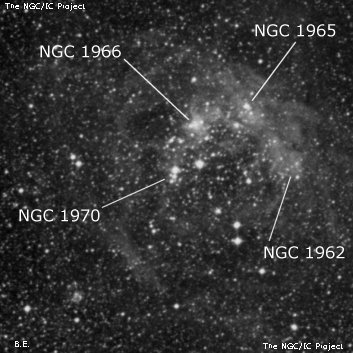
John Herschel discovered NGC 1970 = h2869 on 31 Jan 1835 and recorded "The last nebula in the group of four [with NGC 1962, 1965 and 1966] with stars. Place concluded (with no precision) from the 1st and 3rd by the aid of a diagram." [Plate VI, fig 20]. Despite his uncertainty with the position, it is pretty accurate. Dunlop discovered the entire group (D 136 = S-L 476) and described "a faint confused pretty large nebula. There are a multitude of small nebulae in this place." His position is ~10' too far SW (typical error), though he did not distinguish individual components. Herschel noted the possible equivalence with D 136.
The complex was also sketched by Joseph Turner in Dec 1875 using the 48" Great Melbourne Telescope (plate III.30 at www.docdb.net/history/texts/1885osngmt________e/lithograph_m_3_30.php). His sketch shows the three stars oriented NNW-SSE with no nebulosity, but there is a patch of nebulosity surrounded by a ring of stars that is sketched close north. Pietro Baracchi also took this group of four or five stars as GC 1175 = NGC 1970.
600/800mm - 24" (4/7/08 - Magellan Observatory, Australia): at 200x; NGC 1970 is at the SE corner of the NGC 1962-65-66-70 complex (stellar association LH 58). It consists of three close collinear stars oriented NNW-SSE with the brightest mag 10.8 star at the north end. Using a UHC filter, the stars were surrounded by only very weak nebulosity that was no more prominent than the general field haze. HD 269546 = Brey 34, a mag 9.9 Wolf-Rayet binary (WN5+B3) and the brightest individual star in the complex, is just 0.7' WNW of the 3 stars.
Notes by Steve Gottlieb
NGC 2014
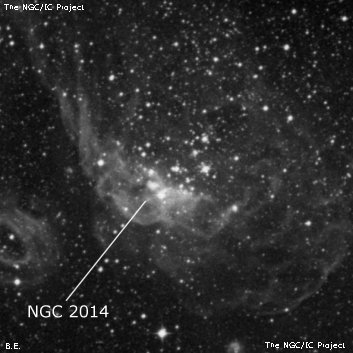
John Herschel discovered NGC 2014 = h2900 on 23 Dec 1834 and described the "chief *9 of a very irreg cluster, 4' long, 3' broad." On a second sweep he logged "a pretty L irreg cluster 7th class; chief *9m taken (at leaving the field); the rest are 10...15m." His position is accurate.
James Dunlop possibly discovered this cluster (D 217?) earlier on 3 Aug 1826 with his 9" reflector from Parramatta, NSW, and recorded "a rather well-defined nebula, 40" or 50" diameter. Dunlop observed this object 3 times and his position is 5' SSW of the cluster. Despite Dunlop's relatively good position, JH did not credit Dunlop with the discovery and Dunlop's description for D 217 implies a much smaller object, so I'm also hesitant about this identification.
600/800mm - 30" (11/5/10 - Coonabarabran, 264x): very bright, large cluster or star cloud (stellar association LH 76) with nebulosity, ~50 stars resolved in a 5' region (no distinct boundary on the north side), including many in a 2' string, elongated N-S. A mag 10 star (brightest in the cluster) is at the south end of this string. A portion of the cluster is immersed in nebulosity (Henize N57A), most prominently on the southeast side of the cluster. Irregular haze (roughly elongated SW-NE) extends out of the cluster for a couple of arc minutes on the east side, spreading south and north (part of a Superbubble). NGC 2014 forms an interesting contrast with emission nebula NGC 2020 5' ESE. The remarkable Seagull Nebula (NGC 2030, 2032, 2035) lies ~20' NE.
Notes by Steve Gottlieb
NGC 1770
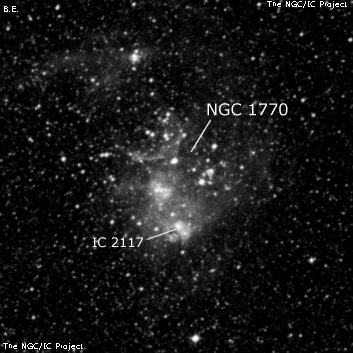
S-L 105, located 13' SW of NGC 1770, was observed using a 25" on 17 Oct 2017. It appeared moderately bright, fairly small, round, 30" diameter. Contains a relatively large bright core but there was no resolution. An additional 6' SSW is N86, a verified LMC supernova remnant. It was picked up unfiltered as a large, low surface brightness hazy region, just south of a mag 11.8 star. A couple of 14th mag stars appear involved with the haze. There was a weak contrast gain adding a NPB filter, with the most evident section ~1' diameter [centered 1.2' S of the mag 11.8 star] and slightly brighter on the east side.
James Dunlop discovered NGC 1770 = D 169 = h2715 with his 9" reflector and described a "pretty bright pretty large nebula, of an irregular round figure, 5' diameter; a little brighter in the middle." He made 2 observations and his position is accurate. John Herschel attributed the discovery to Dunlop and described the object on 23 Nov 1834 as a "cluster of 6th class; pretty rich, large, irregular figure, brighter in the middle; stars of 11..18th mag; fine object." On a second sweep he wrote "A star of 9th mag, the chief of a cluster of 6th class, 4' diameter; nebulous. The most condensed part is 1' south of the stars."
400/500mm - 18" (7/9/02 - Magellan Observatory, Australia): this LMC object is an interesting mix of a star cluster (OB-association LH 12) and an associated emission nebula (LMC-N91A = IC 2117), with the nebulosity mostly on the south side. A mag 10 star is near the center, along with a number of mag 11-12 and fainter stars. The stars are mostly on the north side of the nebulosity with several in small clumps.
600/800mm - 25" (4/4/19 - OzSky): at 244x; very impressive, bright nebulous cluster 5' in diameter. Unfiltered includes over two dozen stars from mag 11-14 with a few pairs. Most of the stars are on the north and west side and include an 11th mag star (HD 268804) near the center and another mag 11 star on the west side. The western component of a 9" pair of mag 12.6/13.2 stars on the north side is a Wolf-Rayet star Brey 10 (HD 32402). Two very bright emission knots with a total size of 2' are on the south side; the southernmost knot is IC 2117.
The entire field displayed a very strong response to a NPB filter with the nebulosity irregular and patchy and the two main nebulous patches on south side intensely bright. With careful viewing Brey 10 was surrounded by a very thin, dim arc (Wolf-Rayet bubble) of perhaps 150?, extending NW to SE of Brey 10 (opening to the NE) with a diameter of 1.5'. The SW edge of the arc was just north of (HD 268804. The arc was subtle and visible only intermittently.
Notes by Steve Gottlieb
NGC 1814
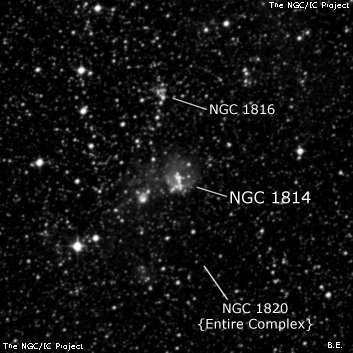
John Herschel discovered NGC 1814 = h2748 on 2 Nov 1834 and described as "The southern of two nebulae [with NGC 1816] in the same cluster of stars [NGC 1820]." On a second sweep his description reads "vF, R, a nebulous knot in the south preceding part of a cluster".
600/800mm - 24" (11/18/12 - Magellan Observatory, Australia): bright, small, elongated N-S "knot" of stars on the west side of the LMC association NGC 1820 = LH 19. Three stars are resolved within the 24" glow. Faint, irregular nebulosity encompasses the knot. Forms a close pair with NGC 1816 2.5' NNE.
Notes by Steve Gottlieb
NGC 1816
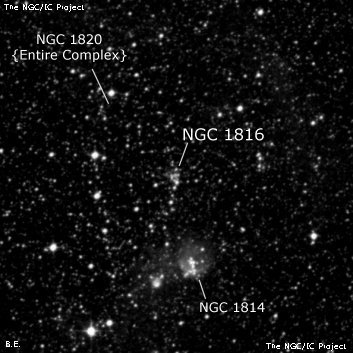
John Herschel discovered NGC 1816 = h2748 on 2 Jan 1837 and recorded "vF, R, another nebulous knot [along with NGC 1814] in the cluster [NGC 1820]". Shapley and Lindsay (1963) group NGC 1814, 1816 and[NGC 1820 together and note "bright scattered stars in nebulosity", with a size of 6.8' x 4.5'.
600/800mm - 24" (11/18/12 - Magellan Observatory, Australia): small, brighter "knot" on the west side of the LMC association NGC 1820 = LH 19. At 200x, a couple of stars are resolved within the 18" glow. Forms a pair with slightly brighter NGC 1814 2.5' SSW.
Notes by Steve Gottlieb
NGC 1820
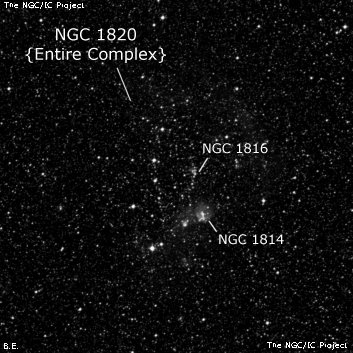
John Herschel discovered NGC 1820 = h2754 on 2 Jan 1837 and described a "pL, rich, 6th class cluster, irregular figure, in radiating streaks. Place that of a star 10th mag (one of 3 such). It is within this cluster that the two nebulae [NGC 1814 & NGC 1816] occur."
600/800mm - 24" (11/18/12 - Magellan Observatory, Australia): this star cloud or association (LH 19) in the LMC appears as a very large, irregular group of approximately two dozen stars mag 10-15, roughly 9'x5' and extended N-S. Includes five stars mag 12 or brighter, along with two brighter "knots" (NGC 1814 and 1816) on the west side as well as containing some irregular nebulosity (LHa120-N17).
Notes by Steve Gottlieb
NGC 1850
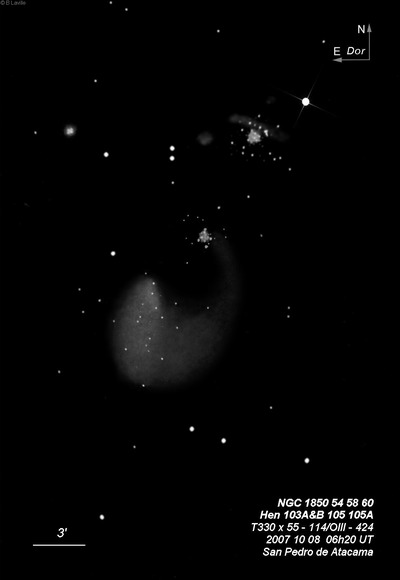
NGC 1850 lies in a very impressive region of the LMC (near the outskirts of the central bar) with 13 additional NGC clusters/nebulosity within 30' including NGC 1854 7' SE, NGC 1858 10' SE, NGC 1856 22' SSE and several others including NGC 1836, 1839, 1847, 1860, 1863, 1865. Unfortunately dawn was starting to break so I only was able to view the first group of objects mentioned above and I need to return to this field!
James Dunlop discovered NGC 1850 = D 172 = h2780 on 3 Aug 1826 and described a "pretty bright round nebula, 40" diameter. This is the preceding and brightest of three nebulae in a line." His position was 10' too far east but correct in declination. The other two "nebulae" are NGC 1855 and 1858. D 170 may be a duplicate observation ("a pretty large faint nebula, irregular figure.")
John Herschel observed this cluster on 6 sweeps beginning on 2 Nov 1834 when he logged "pretty bright, small, round, a cluster of stars 12th mag; diam 1'." The 2nd sweep was recorded as "globular, very bright, very much compressed, 3' diameter." On the third sweep he noted "globular, a fine large clusgter st = 13m, mbM." Herschel gave possible synonyms with D 172 as well as D 170.
400/500mm - 18" (7/10/05 - Magellan Observatory, Australia): After the Tarantula region (30 Doradus complex), NGC 1850 is the brightest star cluster in the LMC and at an estimated age of only 40-50 million years, this rich, globular-like cluster has no counterpart in the Milky Way! At 128x, the cluster appeared very bright (9th magnitude), large, round, ~3.5' diameter, well concentrated with an intensely bright 1' core. A brighter mag 13 star is superimposed on the western side of the halo. Several very faint stars are resolved in the very lively halo.
600/800mm - 24" (4/5/08 - Magellan Observatory, Australia): at 350x in the 24" I was stunned by the view of this huge, extremely bright, blue globular cluster! The outer halo, which extends 5' in diameter, was resolved into dozens of faint stars arranged in irregular star chains that appear to stream out of the core. A single brighter mag 13 star is superimposed on the west side [30" W of center is the core of companion cluster NGC 1850A]. The center is highly concentrated with an extremely bright 1' core that appears elongated, irregular and clumpy with a curved outline. A small, 20" diffuse glow is embedded at the north edge of the halo (open cluster S-L 260).
NGC 1850 resides in a glorious LMC region that is packed with an unbelievable number of clusters and HII regions including NGC 1854 6' SE and NGC 1858, a huge cluster and nebulosity, ~10' SE. A faint loop of nebulosity (LMC-N103A) is involved with the cluster, extending ~N-S on the east end, but I didn't try a filter to see if it was visible.
Notes by Steve Gottlieb
NGC 1874
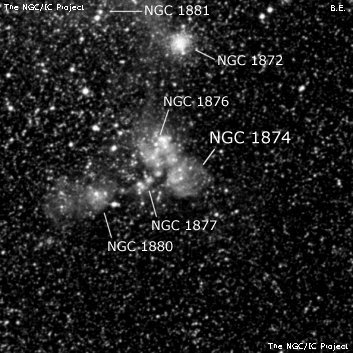
James Dunlop probably discovered NGC 1874 = h2803 = D 122? and described "a small nebula, about 20" diameter, with three smaller nebulae following, and three pretty bright small stars on the north side". His position of 14' due south of the NGC 1874/1876/1877/1880 complex, so he probably saw several or all of these.
John Herschel independently discovered NGC 1874 = h2803 on 16 Dec 1835 and described as "the south preceding of two [with NGC 1876 = h2804], forming a binuclear nebula at the southern extremeity of an arc-formed cluster of stars." Also in this grouping are NGC 1877 and NGC 1880. Sketched on Plate III, figure 6 in his CGH observations. His position is accurate.
600/800mm - 24" (4/5/08 - Magellan Observatory, Australia): this is the first in a complex of HII regions located ~4' due south of the bright cluster NGC 1872. At 200x and UHC filter, NGC 1874 appeared bright, round, ~1' diameter, even surface brightness. The nebulous glow is just slightly fainter than NGC 1876 which is just 1.3' NE. Without a filter a couple of mag 14 stars are involved within the glow.
Notes by Steve Gottlieb
NGC 1955
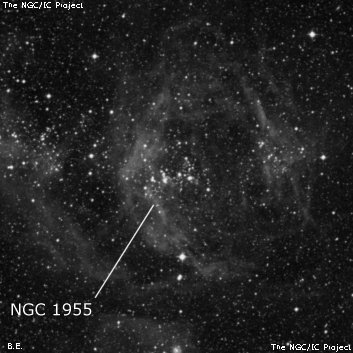
The cluster, which is part of stellar association LH 54, includes as many as 40 stars in a 4' region including a half-dozen mag 11.5-12.5 stars in a 3' gently curving arc elongated E-W. Near the W end of this arc is mag 11.6 HD 36402 = Brey 31, a Wolf-Rayet binary (WC-type).
The cluster is immersed in a large, irregular haze that was brightest on its eastern side in a 30" circular glow. This patch is just a locally brighter section of a large irregular loop bowed out to the east and extending N-S for 6'-7' to a mag 9.5 star 3.5' S of the cluster.
A fainter group of stars and haze lies 4' W (S-L 456 within association LH 51) and the DSS reveals both halves are the brightest portions of an 8' superbubble (LHa 120-N51D). NGC 1968 lies ~8' ENE and NGC 1974 11' NE.
James Dunlop discovered NGC 1955 = D 211 on 3 Aug 1826 and described "a small faint elliptical nebula, about 20" diameter. This is the preceding in a curved line of six or seven small nebulae, of unequal magnitudes." Dunlop made 4 observations and his position is just 1.6' too far SE. JH called NGC 1955 = h2863 "The second of a great line of rich clusters NGC 1968, 1974 and 1991] which are connected by abundant scattered stars. (The first not taken)." The first is probably S-L 456. JH credited Dunlop with the discovery.
600/800mm - 30" (11/5/10 - Coonabarabran, 264x): this cluster and emission nebula is near the western end of a beautiful curved chain of bright clusters involved with prominent nebulosity (referred to as the "Sextant Arc") that extends 17' WSW to ENE and includes NGC 1966 and NGC 1974 to the NE and S-L 456, a group of stars and nebulosity 4' W of NGC 1955.
Notes by Steve Gottlieb
NGC 1968
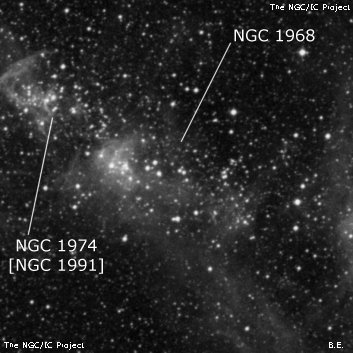
John Herschel discovered NGC 1968 = h2870 on 2 Jan 1837 and described "The third of a great line of rich clusters [with NGC 1955, 1969, 1971, 1972 and 1974] all connected by abundance of irregularly scattered stars." His position is 1' too far west.
600/800mm - 30" (11/5/10 - Coonabarabran, 264x): NGC 1968 is the third in a great chain of clusters involved in extensive nebulosity oriented southwest to northeast. The cluster is bright and very elongated 3'x1' E-W with ~20 stars including a number of mag 12-13 stars. The cluster (part of association LH 60) is surrounded by nebulosity (Henize N51C) that brightens on the east end in a large, round knot and extends beyond the cluster on the south side for several arc minutes in the direction of NGC 1955 to the WSW. NGC 1968 is connected to NGC 1974, another nebulous cluster 3' NE and NGC 1955 lies 8' WSW. The entire complex is nicknamed the LMC "Sextant Arc".
Notes by Steve Gottlieb
NGC 1974
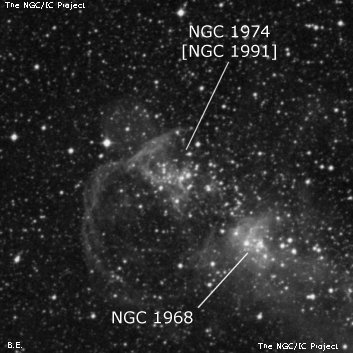
600/800mm - 30" (11/5/10 - Coonabarabran, 264x): NGC 1974 is the fourth in a great looping chain of clusters and nebulosity (collectively called the "Sextant Arc") including NGC 1955 and NGC 1968 to the SW. NGC 1974 is virtually attached to NGC 1968, only distinguished by less nebulosity and stars. Roughly three dozen stars were resolved in a 3' circular group (stellar association LH 63) including a number of mag 12-13 stars. The cluster is involved in fairly bright nebulous haze (LMC-N51A). A filament of nebulosity on the NE side is the brightest part of an incomplete superbubble.
Notes by Steve Gottlieb
NGC 2050
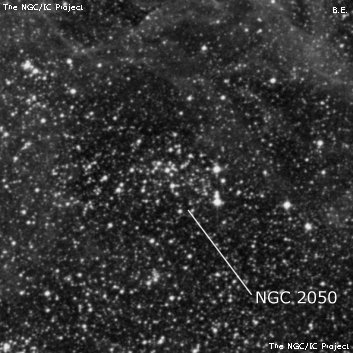
John Herschel discovered NGC 2050 = h2928 in 1834-1835 (exact date unknown as based on a sketch of the Tarantula Nebula (NGC 2070) made over several nights in Nov 1834 and Dec 1835). He described this object "Cl VI; vF st and nebulosity of irregular branching figure, or rather 3 clusters connected. See Notes on Catalogue of Nubecula Major." His position falls in the north-central portion of NGC 2055, a very large association and probably included part of the stream of stars mentioned in my description.. See Harold Corwin's notes for more on this object.
300/350mm - 14" (4/4/16 - Coonabarabran, 145x): NGC 2050 was taken as a 2'-3' patch of stars on the north side of the large stellar association LH 96, a 15'x10' cloud of roughly 120 stars. At 145x, ~20 stars were resolved including HD 37974, mag 10.9 blue supergiant at the west edge and a mag 10.7 star (11" double) at the southwest edge. The central part contains several mag 12 stars. A long stream of mag 10-12 stars begins about 12' SW of the cluster and extends east-northeast for over 20', passing just south of the Tarantula Nebula, and heads towards NGC 2100. Several of the nearby stars in this stream may also be part of NGC 2050.
400/500mm - 18" (7/8/02 - Magellan Observatory, Australia): at 173x, appears as just a locally brighter spot containing perhaps a dozen stars over a hazy background glow (stellar association LH 93), ~2' in diameter. Embedded in the edge of an amazing 15'-20' linear stream of stars (association LH 93/94) which runs through the field from east-northeast to west-southwest. This long chain passes just off the south side of the tendrils of the Tarantula Nebula and heads towards NGC 2050! NGC 2050 is situated 30' SW of the center of the Tarantula.
Notes by Steve Gottlieb
NGC 1747
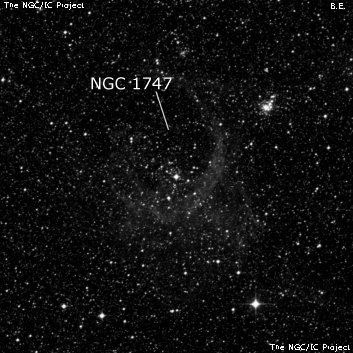
John Herschel discovered NGC 1747 = h2701 on 2 Nov 1834 and described as "A star 9th mag in the centre of a poor cluster of very small stars, 4' diameter."
400/500mm - 18" (7/9/02 - Magellan Observatory, Australia): at 128x and UHC filter, this LMC nebulous cluster appeared as a fairly large, low surface brightness glow, ~4' diameter encasing a mag 9.7 star (HD 32034). Without the filter the cluster consists of a number of mag 12 and fainter stars that huddle around the bright star. On the DSS, the emission component (N9) is a nearly complete large bubble of 5'-6' in diameter (open on the NE end) with the bright star in the interior to the southwest of center. The stellar component is part of association LH 6. NGC 1735 lies 6.5' NW and NGC 1774 is 17' ESE.
Notes by Steve Gottlieb
NGC 2004

James Dunlop discovered NGC 2004 = D 215 on 24 Sep 1826 and described "a round well-defined nebula, about 20" diameter, bright at the centre." Dunlop reported 3 observations and his position is 5.5' WSW of center (relatively accurate for him).
John Herschel observed this bright cluster (h2893) on 6 sweeps: on 2 Nov 1834 he recorded "B; pretty rich; compressed cluster of stars 12m." Next he recorded "globular, B; irreg; R; 2'. The stars are easily distinguishable." On a third sweep he wrote "globular, B; S; R; comp M to a blaze of stars. Many stragglers." His position is accurate.
600/800mm - 30" (11/5/10 - Coonabarabran, 264x): bright, superb cluster, ~3' diameter. Contains a small, brilliant core and a highly resolved halo that is packed with 50 stars. The surrounding field is quite rich in both faint and brighter mag 11-12 stars. The NGC 1955/1968/1974 complex lies ~20' SW and the NGC 2014/2020 complex lies 27' SSE.
Notes by Steve Gottlieb
NGC 2042
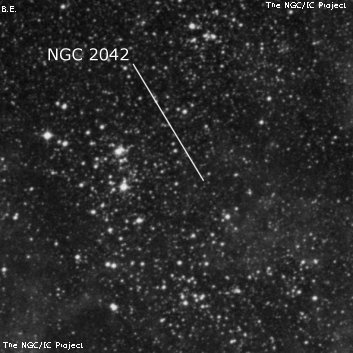
John Herschel discovered NGC 2042 = h2922 on 30 Dec 1836 and recorded "the chief star (9th mag) of a large, irregular figured, looped or hooked cluster of stars 12..15th mag, rich and various, and filling the field." His description and position applies to the assocation LH 89.
This object may have been discovered earlier by James Dunlop. His D181, described as a "small faint nebula, 10" or 12" diameter" is 5.5' NW of center of the association. But the description doesn't match an object of this size. His D 140, described as "a small faint round nebula" is a similar distance SW of center, but again the description is a very poor match. Finally D 183, described as "a faint ill-defined nebula, 20" diameter", is ~8' NE but another poor match in description. So, I'm not confident any of these observations referring to NGC 2042.
400/500mm - 18" (7/8/02 - Magellan Observatory, Australia): fairly large patch of stars and haze (association LH 89), ~5' in size. At least two dozen stars are resolved in an elongated group oriented SW-NE, including a few mag 10 stars over unresolved stars or outer nebulous haze from the Tarantula complex. Two additional knots are to the northwest and form an obtuse isosceles triangle with NGC 2042. The first knot is KMHK 1122 situated 5' NW and S-L 585 is 10' NW. NGC 2042 is located just 17' NW of the center of the Tarantula Nebula.
600/800mm - 25" (4/3/19 - OzSky): very large group of stars with unresolved haze (association LH 89), extending nearly 10' from north to south and contains a couple of knots of stars, a few dozen mag 12-14 stars, a mag 10.3 star at the west tip and numerous mag 15+ stars.
BRHT 16a, situated near the center, is a very bright knot near the center, ~10" diameter. A very faint star was resolved at the west edge.
KMHK 1122, on the north east side (2' NW of BRHT 16a), resolved into a 10" pair of stars at the center, encased in a very small glow. Several stars (mostly faint) were resolved nearby including two two mag 12.5 and 12.8 stars close east of the central pair and some mag 15 stars around the edges.
Notes by Steve Gottlieb
NGC 2060
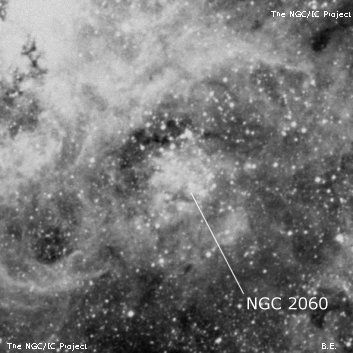
John Herschel discovered NGC 2060 between Nov 1836 and Mar 1837 with a 5-inch refractor and listed it as #642 in his preliminary catalogue of "Stars, Nebulae and Clusters in the Nubecula Major." (not included in his main CGH catalogue). His position corresponds with this SNR on the southwest side of the Tarantula nebula.
400/500mm - 18" (7/8/02 - Magellan Observatory, Australia): this fairly small knot of nebulosity is situated just southwest of the Tarantula nebula, approximately 7' from the center. About a half-dozen mag 12-14 stars are involved (association LH 99) in the glow with a total diameter of 2'. A mag 12 "star" at the north edge (Brey 73 = TLD1) is actually a very compact cluster with over a dozen components, including the Wolf-Rayet star.
NGC 2060 harbors a compact x-ray source and a rapidly rotating pulsar, indicating an obscured Crab-like supernova remnant (1998 IAU Circ., 6810, 2). The cluster also contains VFTS 102, the most rapidly rotating massive O-type star known, which is possibly related to the pulsar.
600/800mm - 25" (4/3/19 - OzSky): at 244x; Brey 73 appeared as a very high surface brightness knot (V = 12.1), ~12" diameter, with a mag 13.7 star at the SE edge.
Notes by Steve Gottlieb
NGC 2100
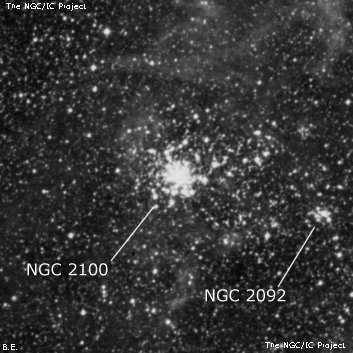
James Dunlop probably discovered NGC 2100 = D 154? on 25 Sep 1826 and reported "a pretty bright round or rather elliptical nebula, 25" diameter." His position is 5.6' ESE of the cluster, well within his typical errors. Glen Cozens assigns D 151 to NGC 2100. Dunlop described this entry as "a faint ill-defined small nebula" and the position is just 2.5' NW of the cluster. Finally, JH also suggest that D 147 might be an equivalence. This entry is 8.4' WSW of the cluster and the description reads "a pretty bright round or rather oval nebula, 30" diameter." This description is very similar to the one for D 154.
On his first sweep of 3 Nov 1834, JH described NGC 2100 = h2966 as "a bright S cluster of distinct stars (thick haze)." On a second sweep he wrote "the cluster sf the great looped nebula." On a third occasion he called it "globular cluster, irr R, psmbM, 2'." His 4th sweep reads "globular, B, R, 3', all resolved into stars 13..16th mag." His final record states "B, S, m compressed, not mbM; irregular oval, 3', stars distinct 13th mag." He noted it might be equivalent to Dunlop 154, 151? or 154??
400/500mm - 18" (7/8/02 - Magellan Observatory, Australia): this LMC cluster appears as a small, bright (V = 9.6) clump of stars and unresolved haze with a diameter of ~2'. Fairly compact and isolated with at least 10 mag 12 and fainter stars resolved. Located 20' ESE of the core of the Tarantula nebula within the LMC OB-association LH 111. On the DSS, this appears to be a very rich open cluster or globular within a larger association. NGC 2092 lies 4' WSW and NGC 2108 is 10' ENE.
Notes by Steve Gottlieb
NGC 1818
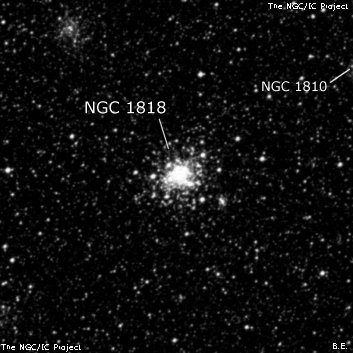
James Dunlop discovered NGC 1818 = D 236 = D 234? = D235? = h2749 on 3 Aug 1826 and described (for D 236) as "a small nebula, 20" diameter, with a very bright point in the centre." He observed it twice and the published position is 3.4' ENE of center. D 234 was described as "a round well-defined nebula, about 30" diameter." This entry has a single observation and the position is 8.5' SSW of center. D 235 was described as a "small round pretty well-defined nebula" and his position is 5.5' NNW of center!
John Herschel made 6 observations of the cluster with the first description from 2 Nov 1834: "vB, S, R cluster of distinct stars, mbM, 2' diameter."
600/800mm - 30" (11/4/10 - Coonabarabran, 264x): very bright, fairly large, 2.5' diameter, sharply concentrated with an intense core that is partially resolved into several very faint stars. The halo was fairly well resolved with two dozen faint stars plus some brighter mag 12-13 stars in the outer halo. Just off the southwest edge is KMHK 490, a very small non-stellar object that appeared like a close double star. NGC 1818 is the brightest of a trio with NGC 1810 6' NW and S-L 205 5' NE. S-L 205 is just a faint, diffuse glow, roughly 35" diameter. NGC 1822 and NGC 1826, a fainter pair of clusters, lie 14' NNE. NGC 1818 is a "young" blue globular (YPC), formed only 40 million years ago.
Notes by Steve Gottlieb
NGC 1866
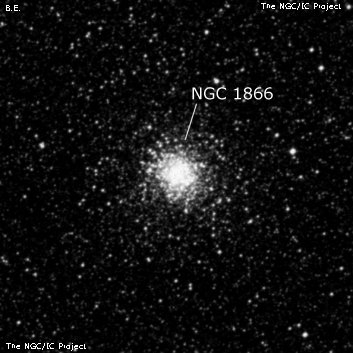
James Dunlop discovered NGC 1866 = D 247 = D 248 on 3 Aug 1826 and described (for D 247) "a pretty bright round nebula, 40" diameter." His position for this entry (1 observation) is 10' too far NW. Dunlop described D 248 as "a pretty bright round well-defined nebula, about 30" diameter, gradually brighter to the centre." He claims 3 observations for this object and the published position is 9' too far east. Since both descriptions are quite similar and this is the only bright object in the vicinity, it's reasonable to assume D 247 = D 248 = NGC 1866. John Herschel described NGC 1866 = h2793) as "vB; L; R; vgmbM; 2'; resolvable." and listed both Dunlop entries as possible equivalences. In 1926, Robert Innes described the cluster as "fine cluster of stars, very dense, with outliers, 2' diam, a miniature of Omega Centauri, 8th mag." (26-inch refractor, Union Observatory).
300/350mm - 13.1" (2/17/04 - Costa Rica): at 166x, this LMC globular appeared moderately bright and fairly large large, round, 2.5' diameter. The appearance was symmetrical with a faint 2.5' halo increasing to a 1' bright core which was concentrated to the center. There was no obvious resolution although the surface was grainy or mottled. Forms an equilateral triangle with a mag 11-12 star 3' WNW and a mag 12-13 star 3' NNW. This is a young populous "blue globular" with an age of roughly 100 million years.
600/800mm - 30" (11/6/10 - Coonabarabran, 264x): beautiful, highly resolved "blue globular" in the LMC. Appeared very bright, very large, with an intense 1' core surrounded by a 5' halo containing a few dozen very faint stars. The core itself was partially resolved into a number of densely packed stars over bright, mottled haze. NGC 1859 lies 18' NW.
Notes by Steve Gottlieb
NGC 1549
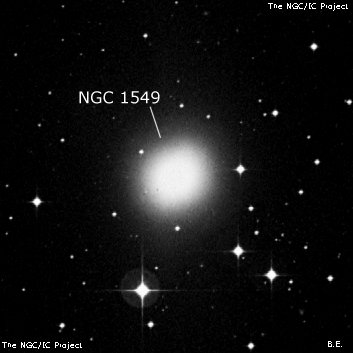
John Herschel discovered NGC 1549 = h2629 on 6 Dec 1834 and noted "B, R, 40 arcseconds." (single sweep). Wolfgang Steinicke originally credited James Dunlop with the discovery, though Glen Cozens states D 331 applies to NGC 1553 with a 1 hr error in RA and that Dunlop missed NGC 1549 for some reason (possibly poor conditions because of dew on optics). Steinicke now credits JH with the discovery. Innes (MN 59, 339, 1899) and DeLisle Stewart's corrected position in the IC 2 Notes section is accurate (Herschel's RA was uncertain).
300/350mm - 13.1" (2/19/04 - Costa Rica): bright, moderately large, round, 1.5' diameter. Strongly concentrated with an intense 30" core and a bright stellar nucleus with direct vision. Cradled by a distinctive group of 5 stars including mag 8.7 SAO 233458 to the SSE. This member of the Dorado Group forms an interacting pair w/NGC 1553 12' SSE.
Notes by Steve Gottlieb
NGC 1994
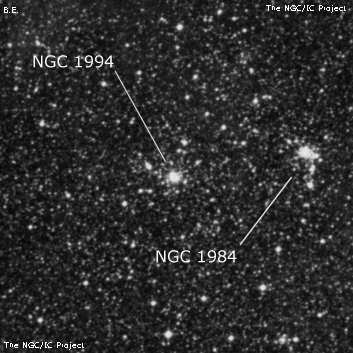
John Herschel discovered NGC 1994 = h2887 on 16 Dec 1835 and described "a little knot, a triple, perhaps a quadruple star, forming a point of reference in a cluster of the 7th class. The knot looks like a nebula till analysed." On a second sweep he logged "the second knot in a rich cluster of irregular figure of stars 11..16th mag. The knot seems to be a close double or triple star." His position is accurate.
600/800mm - 25" (10/10/15 - OzSky): at 318x; very bright, small, very high surface brightness knot, 25" diameter, slightly elongated E-W. A few stars are resolved in the cluster and many are scattered very nearby. In a very rich region of the LMC and third of three clusters with NGC 1984 and 1967.
Notes by Steve Gottlieb
NGC 1731
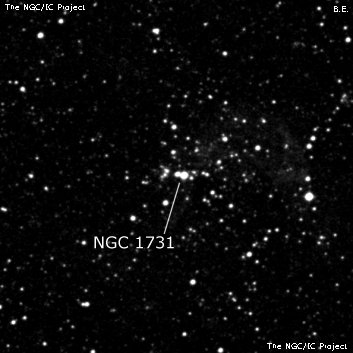
John Herschel discovered NGC 1731 = h2691 on 23 Dec 1834 and described "a double star, the chief of a pretty rich, pretty large cluster of loosely scattered stars, little compressed to the middle; 8'; stars 11..15th mag." On a second sweep he called it "a poor loose cluster 8' diameter, stars 10..15th mag, chief double star taken." and on his third and last sweep, "a double star, the chief of a poor loose cluster 3 or 4' diameter."
400/500mm - 18" (7/9/02 - Magellan Observatory, Australia): at 128x this is a large region of nebulosity (LHa 120-N4, a confirmed supernova remnant) and scattered stars (association LH 4), 6'-7' diameter. The double star h3710 = 10.7/12.7 at 12" is involved on the east side, along with a number of fainter stars.
Notes by Steve Gottlieb
NGC 1755
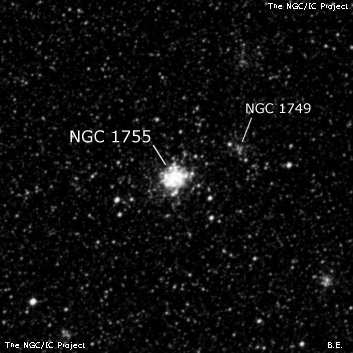
James Dunlop discovered NGC 1755 = D 167 = h2706 on 3 Oct 1826 with his 9" reflector and described a "pretty bright round well-defined nebula, 15 arcsec diameter." Dunlop made two observations and his position is 7' west of center. John Herschel made a single observation on 30 Dec 1836 and recorded "very bright, round, gradually brighter in the middle; 60". The following of two [with NGC 1749] in the field."
Pietro Baracchi observed NGC 1755 and NGC 1749 on 10 Dec 1884 with the 48" Melbourne telescope. His sketch shows NGC 1755 as very mottled with a distinct star at the south edge and another at the northwest edge. At the same time he discovered S-L 92, an extremely faint cluster 5' SW. He wrote in his notebook, "Nebula not in Calalogues. Very faint, a little elongated, no condensation." The discovery was not published.
400/500mm - 18" (7/9/02 - Magellan Observatory, Australia): bright, compact cluster, round, 1.5' diameter, brighter core, no resolution. Forms a pair with much fainter NGC 1749 2' NW.
Notes by Steve Gottlieb
NGC 1761
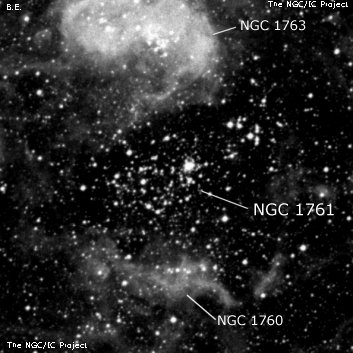
James Dunlop was probably the discoverer of NGC 1761 = D 231 on 6 Nov 1826, recording "a faint round nebula, 1' diameter." His position is 15' too far south, a typical error. This identification is reasonable, assuming D 230 applies to NGC 1763 (Bean Nebula), although Steinicke applies D 230 to NGC 1760, a much less obvious object.
John Herschel independently discovered NGC 1761= h2710 on 11 Dec 1835 and recorded the "chief star 9th mag in a large loose cluster." He made 3 observations as well as including it on a sketch (Plate III, fig 3), along with NGC 1760, 1763 and 1769. Joseph Turner sketched the entire complex as well in Apr 1879 with the Great Melbourne Telescope. NGC 1761 is shown as elongated E-W with a number of stars superimposed, particularly around the edges.
300/350mm - 13.1" (2/17/04 - Costa Rica): this rich group of very faint stars is located just south of the south end of the HII region/cluster NGC 1763. On the west side is a quasi-stellar mag 10 object and the cluster is elongated E-W, 2'x1'. On the west side of the brighter star is another small group of faint stars and haze which may be a continuation of the cluster.
600/800mm - 25" (4/4/19): at 244x; Brey 9 was a fairly bright compact knot on the northwest side of NGC 1761. It had a high surface brightness and ~5" diameter. A faint star was attached at the edge forming a "double".
Notes by Steve Gottlieb
NGC 1858
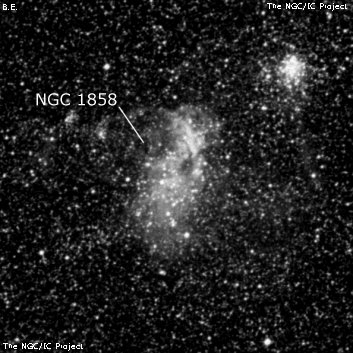
James Dunlop discovered NGC 1858 = D 120 on 3 Aug 1826 with his 9" reflector and described a "small round nebula, about 30" diameter." His position is 14' ESE of this cluster/nebula (association?).
John Herschel missed the earlier observation by Dunlop (not referenced in the CGH catalogue) due to the poor position and independently discovered NGC 1858 = h2784 on 2 Nov 1834, noting "A bright cl of irregular figure." Herschel observed the cluster on no less than 7 sweeps. The next observation was recorded as "a large, irregularly elongated cluster and nebula. Has two bright nebulae N.p." On a third occasion he noted it as "bright, large, irregular figure; binuclear; 3' long, 2' broad. The S.f. of 3." His final observation was recorded as "Two oval nebulae joining." He notes: "This object, by diagrams, made in several of the observations, appears to consist of a resolvable and irresolvable portion, the general form being that of a somewhat crooked oblong extended from N.p. to S.f. at an angle of 60 or 70 degrees with the parallel, the northern end being nebulous, the southern starry. This anomolous form and constitution will serve to explain the apparent disagreement of these descriptions and places."
400/500mm - 18" (7/10/05 - Magellan Observatory, Australia): third of three bright objects in a NW to SE string with NGC 1850 and NGC 1854/55. This is a large and very unusual cluster with nebulosity. There is a bright knot attached near the NW edge, ~15"-20" in diameter. This knot responds very well to a UHC filter at 76x (27 Panoptic). An obvious elongated patch of nebulous haze curves to the SE with several mag 13 stars involved with the glow and extended N-S. Overall, the size of the cluster/nebulosity extends to 3.5'x2'. Located 4.5' SE of NGC 1854.
600/800mm - 24" (4/7/08 - Magellan Observatory, Australia): NGC 1858 would be a fascinating nebula and cluster (association LH 31) even if it was isolated, but it's more striking situated at the southeast end of a wonderful chain with the bright cluster NGC 1854 and NGC 1850, one of the top showpieces in the LMC. At 346x about two dozen stars were superimposed over an elongated glow and many other stars were just outside the glow. At 200x with a UHC filter, the associated emission nebula (LMC-N105) was very bright overall with a very high surface brightness patch (N105A = HD 269111), roughly 30" in size, at the north end. This patch contains the mag 13.9 Wolf-Rayet star Brey 16a = HD 269113. The nebula is brightest along the west and east border and weaker in the center. The elongation is towards a mag 12 star on the south side (Blue supergiant HD 269116). HD 34169, a mag 13.7 star off the west side, is a rare eclipsing binary, consisting of a Wolf-Rayet WN4 star (Brey 16) and an O5-class blue supergiant. The nebulosity forms part of a Superbubble. NGC 1854 lies 4.5' NW.
Notes by Steve Gottlieb
NGC 1983
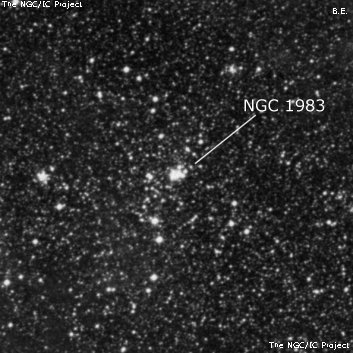
Two additional clusters were picked up nearby to the east (nearly collinear with S-L 492). H-S 314, 3.7' E of S-L 492, appeared as a bright, high surface brightness, compact glow, 20" diameter, no resolution. H-S 319, just 2' E of H-S 314, was noted as fairly faint, small, round, 18" diameter, no resolution. A mag 11.5 is off the southeast side [35" from center] and a mag 12.3 star is 0.7' E.
John Herschel discovered NGC 1983 = h2881 on 11 Nov 1836 and described "a pretty rich irregular cluster which fills the field; a knot in it taken." S-L 492 is the "knot" he measured, but the object which "fills the field" is the association LH 61.
600/800mm - 25" (10/10/15 - OzSky): at 318x; this large star cloud/association (LH 61) includes the embedded cluster S-L 492. It appeared as a very bright, small knot of stars, 30" diameter, with a half-dozen resolved. The star cloud is elongated N-S and is rich in bright and faint stars (too many to count). A very striking N-S string (6' length) of 10 bright mag 10.5-12 stars passes just east of the cluster. Just outside the field to the south (9' from S-L 492) is NGC 1984, along with NGCs 1994 and 1967.
Notes by Steve Gottlieb
NGC 1533
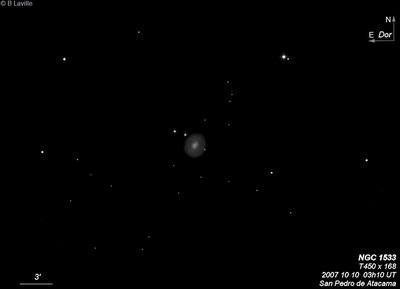
John Herschel discovered NGC 1533 = h2622 on 5 Dec 1834 and recorded "vB, pL, R, smbM to a stellar nucleus. Has two stars 10th mag N.f." His position and description matches ESO 157-003 = PGC 14582.
According to Glen Cozens the original discovery was made by James Dunlop. He reported D 320 as "a small faint nebula, about 12" diameter, with three very small stars north of it." and claims 3 observations. There is nothing at his position, but NGC 1533 is 1? to the north.
300/350mm - 13.1" (2/19/04 - Costa Rica): fairly bright, moderately large, 2.0' diameter, round, contains a small bright core. Collinear with two 11.5 magnitude stars 1' and 2' NE of center. Member of the Dorado group with NGC 1536 24' SSE, NGC 1546 40' E and the NGC 1549/1553 pair less than a degree NE.
Notes by Steve Gottlieb
NGC 1596
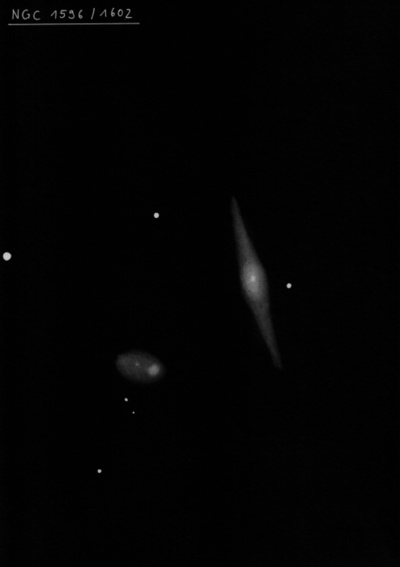
John Herschel discovered NGC 1596 = h2648 (along with NGC 1602 = h2649) on 5 Dec 1834 and recorded "B, mE, pL, psmbM, 60" long. The preceding of two [with NGC 1602]." His position (2 consecutive sweeps) is very accurate. Joseph Turner sketched the pair on 17 Jan 1877 with the Great Melbourne Telescope (p. 130 of his logbook). NGC 1596 is shown as a thin edge-on, sharply concentrated with a very small bright nucleus. A lithograph was prepared (plate II, figure 15) but never published.
300/350mm - 13.1" (2/19/04 - Costa Rica): bright, moderately large, very elongated 7:2 SSW-NNE, 1.8'x0.5', contains a slightly bulging core and tapering extensions. Sharply concentrated with a very small bright core. Paired with NGC 1602 2.9' SE in the Dorado Group of galaxies. NGC 1617 lies 43' NE. Located 55' due west of mag 3.3 Alpha Doradus.
Notes by Steve Gottlieb